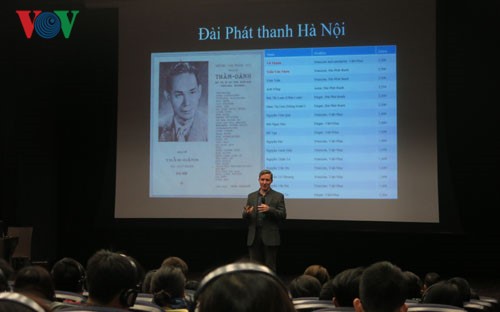(VOVworld)- Lonán Ó Briain, Assistant Professor of Music at the University of Nottingham, recently gave a presentation on the history of Voice of Vietnam’s music at the French Cultural Center L’Espace in Hanoi. Lonan spent a great deal of time talking with VOV musicians and staff to prepare for the presentation.

Assistant Professor Lonán Ó Briain
|
Lonán Ó Briain, Assistant Professor of Music at the University of Nottingham, recently presented his study of the history of VOV’s music since VOV broadcast Vietnam’s Declaration of Independence in 1945.
He described the preparations by VOV’s first reporters and technicians for the broadcast of Vietnam's Declaration of Independence on September 7th, 1945, and the criteria for the selection of a signature tune.
Lonan said messages about Vietnam’s resistance war were spread more widely thanks to radio broadcasts. President Ho Chi Minh’s Declaration of Vietnam’s Independence was the first example. Radio broadcasts were used to popularize various genres of music during that period.
Lonan said that during the war, Vietnamese people had few opportunities to access advanced broadcast technologies so Vietnamese songs of that period learned more heavily on the content.
During the Indochina war from 1946 to 1954, there were only two ways of broadcasting music on VOV, according to Lonan: “There are two types of music that we are talking about today: pre-recorded and music that's actually live on air, which doesn't happen very often nowadays because we can pre-record it and couldn't make any mistakes. So they could play records in Hanoi. They mostly picked up recordings of European popular artists and some classical music from Europe. Some Vietnamese tracks have been recorded. So you got examples of hat cheo tuong, hat van, and cai luong. You can actually buy records of it. It was an unusual thing at a time. So beyond the actual pre-recorded music, VOV had live music in Hanoi. It was a vibrant scene. Beyond the traditional music, Vietnamese music, VOV also had European electrical orchestras which played in the opera house.”
 |
Lonan noted that it was not easy to introduce songs written by musicians like Pham Tuyen, Hoang Duong, Van Chung, and Van Cao to listeners because only a few people had radio sets and radio coverage was not as wide it is now.
Everything changed for Vietnamese artists when tape-recorders were invented. Although broadcasting time remained limited, songs were recorded continuously, enriching music genres, and music was used as the main tool for attracting listeners.
Following the signing of the Geneva Accords, several agencies in charge of music were established in Hanoi. According to Lonan’s research, during this period, musicians and producers could pre-record their songs using magnetic tape recorders. More diverse music programs were produced and the use of music was improved.
Lonan explained further: “To maintain the listenership, they decided to initiate a strict regime of music broadcasting. There are three different ways to broadcast music. First of all is to open a radio broadcast such as with “Diet Phat xit” in signature tune, and then an interlude between programs and announcements to drop people in, and then playing finally pre-recorded music. So records will be be played directly in to the microphone. ….”
VOV remained the only medium for popularizing music rapidly and widely. Nguyen Thi Hien, who lives in Hanoi, said: “I find the talk very interesting through which I have more knowledge of the history of VOV’s music.”
After looking at the history of music on the radio, Lonan concluded that music is the most direct link between listeners and radio stations. Music plays an important role in luring listeners to radio broadcasts.